Z77 mITX Round-Up: Five of the Best – MSI, Zotac, ASRock, EVGA and ASUS
by Ian Cutress on December 31, 2012 7:00 AM EST- Posted in
- Motherboards
- MSI
- ASRock
- EVGA
- ZOTAC
- Asus
- Ivy Bridge
- Z77
- mITX
ASRock Z77E-ITX In The Box
When I reviewed the ASRock P67 Extreme4 in January 2011, for ~$150 we got an amazing box bundle – SATA cables, molex to SATA power cables, SLI bridges, a front USB 3.0 panel, a rear USB 3.0 bracket and a floppy drive cable. Almost nothing I have reviewed since has ever come close in terms of value or sheer amount (the ASUS ROG motherboards and an EVGA Z77 box have been similar). So when I see a smaller motherboard on offer for around the same price, part of me is secretly hoping that the box contents match that of the P67 I reviewed all that time ago.
In the box we get:
Manuals
Rear IO Shield
Driver CD
Two SATA Cables
WiFi Antenna with Stand
DVI-I to D-Sub Adapter
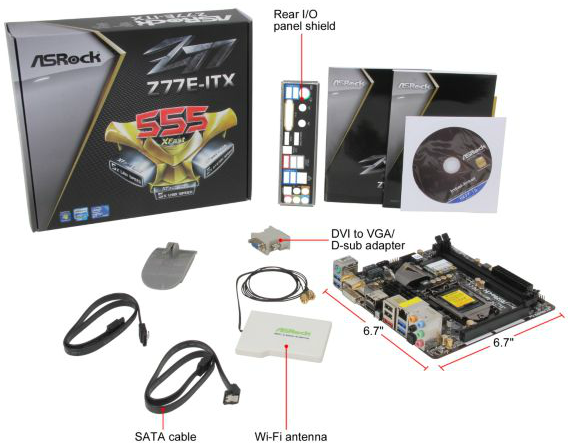
While there is not much in the box compared to those early days, I am glad to see an included DVI to D-Sub adaptor given the DVI-I onboard. The WiFi antenna is a different to the norm – typically in these packages we get a single pair of antennas, but ASRock have decided to mount them into a small plastic device at a near 90º angle for better multi-directional coverage.
ASRock Z77E-ITX Software
For a number of motherboards and motherboard packages, ASRock have stuck to their guns on the software package they include with the product. The main philosophy behind their software package is plastered over the motherboard box itself in the form of the ‘XFast 555’ methodology. This relates to the main three parts of the software – XFast USB, XFast LAN and XFast RAM, each of which we will go through. ASRock claims that each element of the software can increase performance by 5x (hence the 555 nomenclature), however the benchmarks are cherry picked to show a performance gain, and it is arguable if those benchmarks are relevant in a real world context.
The driver install disk is very good – we get a one button option to install the drivers or pick the drivers we want. Other specific software is included in this ‘install all’, like Google Chrome and an anti-virus (this anti-virus software is part of a bundling package with a particular virus scan company, which I disable for the purposes of testing). Other utilities can be installed on a case-by-case basis in the Utilities menu:
Both the XFast USB and XFast LAN utilities on the disk are actually licensed versions of other software but with an ASRock skin. For example, the XFast LAN software is a skinned version of cFosSpeed (http://www.cfos.de/en/cfosspeed/cfosspeed.htm), which normally costs 15.90 Euro. ASRock clearly get it on a bulk licensing deal in order to pass savings onto the user.
XFast USB
The waters of XFast USB have been muddied with the integration of Windows 8. Simply put, there are multiple ways to talk (protocols) to a USB device, depending on whether the one doing the talking and the USB device supports the protocols. For Windows 7 there are three main protocols to choose from – normal (from the Windows Drivers), BOT (Bulk Only Transfer, increases speed at the expense of latency) and UASP (USB Attached SCSI Protocol). In all usual situations, the normal protocol has priority as it works in any configuration with any device. The BOT protocol can be achieved by injecting a different driver into the system (this is what XFast USB does) which gives better peak transfer rates by reducing the overhead in talking to the device. UASP is used by ASUS to get better speeds for low transfer sizes – sometimes up to two orders of magnitude better than normal or BOT protocols.
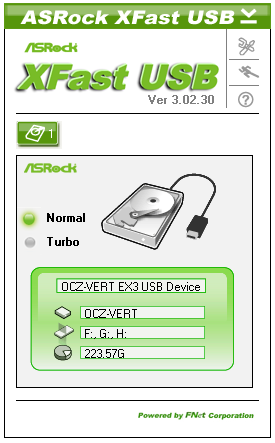
When I say the waters have been muddied, it means that Windows 8 automatically implements UASP on any device that can support it on any USB 3.0 port. This makes software like XFast USB on ASRock and the ASUS UASP null except on Window 7 systems. If Windows 7 is here to stay until Windows 9, then elements like XFast USB will still be included in software packages.
XFast LAN
In my home user experience, there has never been much of a need to monitor and adjust how a machine communicates with the internet. Living with a substantial broadband speed helps, but even as a student there was no software way of stopping someone abusing the internet of the house without setting up an ICS type system and implementing something like XFast LAN, assuming the ICS could interpret what each machine was doing. XFast LAN is the ASRock skinned version of cFosSpeed, and allows users to monitor as well as prioritize certain programs over others for network usage. Thus when gaming and downloading, the game can have priority, or using VOIP over gaming, the VOIP gets ahead of the stack for gaming.
This software is designed to work with any outgoing network implementation – either Realtek, Intel, Atheros, or a WiFi connection. The downside of software usually consumes some CPU cycles rather than gunning for a NIC with routing options part of the specification, such as Intel server NICs.
ASRock eXtreme Tuning Utility (AXTU)
AXTU has been a part of the ASRock package since before I starting reviewing their motherboards, and not a lot has changed since the inception. Most manufacturers have an interface for overclock settings and fan controls, and for ASRock, this is AXTU. Over the months and chipset generations, a couple of new features have been added on to the default framework – Intelligent Energy Saver and XFast RAM.
The Hardware Monitor for AXTU does a similar job to the HW Monitor in the BIOS – we get lists of speeds, temperatures and voltages.
Fan control is also similar to the BIOS options, giving the CPU fan and the chassis fan options to set a target temperature then a target speed (from Level 1 to Level 10 which makes little sense). It would not be too hard to offer a multi-scale graphing system so users can accurately change the fan speed in relation to temperature, given that ASRock have control over what PWM value they set for each fan header.
XFast RAM is part of the 555 software package, although it simply is a glorified RAM Disk generator with some simple options for adjusting temporary files to the RAM Disk. There are situations where this is useful – making 16 GB RAMdisk if you have 64 GB of memory could provide the perfect solution in the read/write speeds of your array are the limiting factor in production. However this is not a perfect scenario in a mITX build unless some higher density non-ECC memory comes into the mainstream.



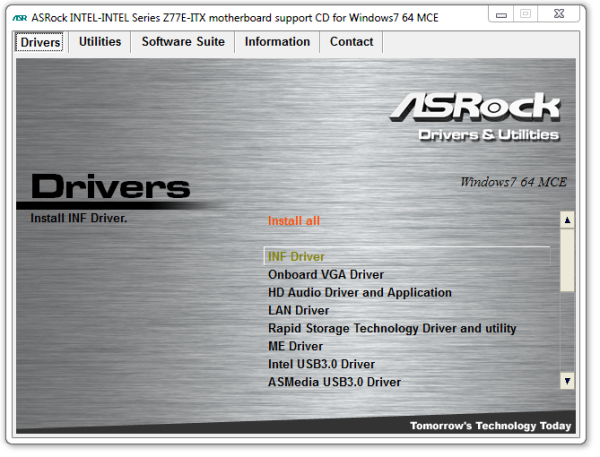
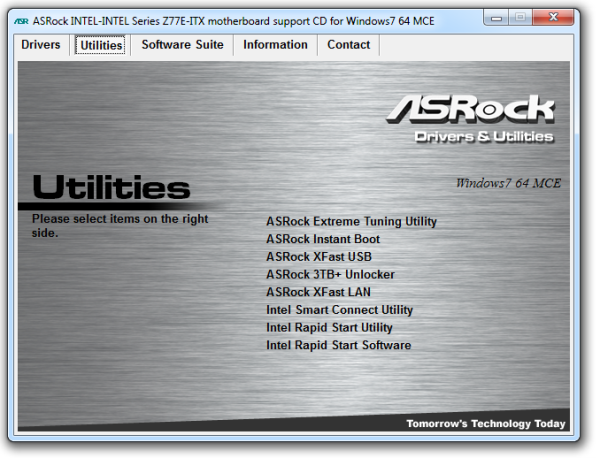
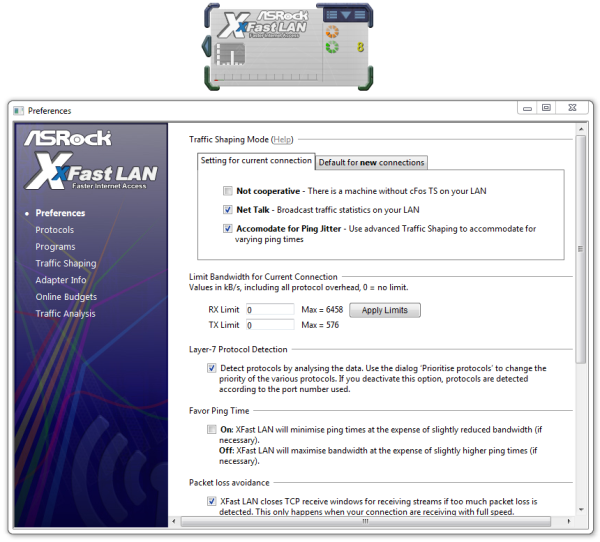
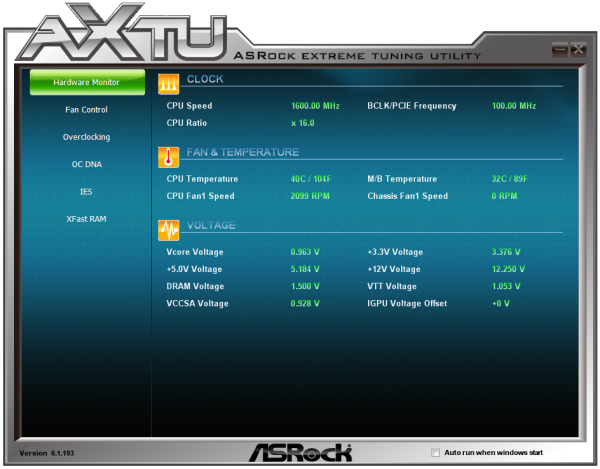
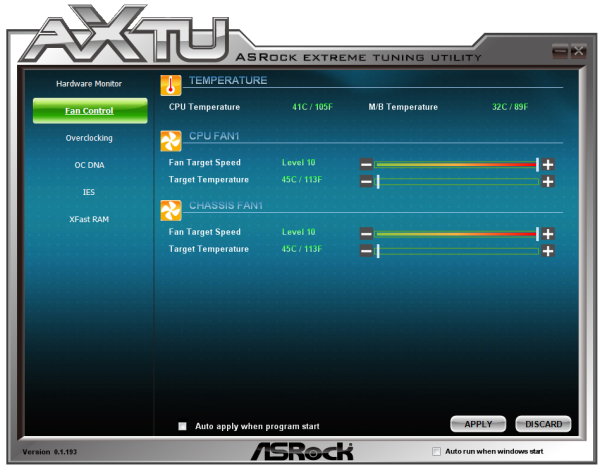















54 Comments
View All Comments
mike_b - Monday, December 31, 2012 - link
Interesting article, but I have to ask why would someone spend more for a Z77 chipset when using 'just' an i3? Surely a much cheaper H61 chipset could do the job admirably, and at much lower cost.Z77 makes sense if you're overclocking, which is excluded from this test...
IanCutress - Monday, December 31, 2012 - link
H61 has no chipset USB 3.0, no chipset SATA 6 Gbps, and you are limited to PCIe 2.0. H61 is also technically limited to one single sided DIMM per channel, and no SATA RAID. There's also SRT to consider, that would be advantageous with the ASRock and the mSATA on the rear.Ian
mike_b - Monday, December 31, 2012 - link
It might make an interesting comparison to see what net advantage is gained with the added features of the Z77 chipset compared with the H61. If budgets are limited the ~100 dollar cost difference between the Z77 and H61 mainboards makes a big difference; that money saved could be put into something which makes more of a performance difference (SSD rather than HDD for example).Anandtech is one of the best tech sites around, you guys do a great job. I do sometimes see though an emphasis on more expensive products when in terms of real-world performance you could get almost the same thing at a much cheaper price. Might be worth mentioning somewhere.
Not least because with yet another new socket coming with Haswell all these 1155 boards will be seen as out of date soon anyway.
IanCutress - Monday, December 31, 2012 - link
Once we get into the swing with Haswell, we will hopefully covering the whole spectrum. Though it is worth noting that motherboard manufacturers, want to put their best foot forward, and would prefer their halo/channel boards get covered before their OEM / low end offerings. Hence this is why you rarely see many mainstream reviews that are not from forums dedicated to the market segment and users testing their own equipment. We are hoping to rectify the balance in due course. If there are any specific products you might want us to test or examine, drop me an email and I'll see what I can put in my schedule (as full as it is[!]) :)Ian
StormyParis - Monday, December 31, 2012 - link
This is a major issue, not limited to motherboards: whenever I'm looking for something middle of the road or outright cheap, I can't find reviews.These Z77 MBs are a nice example: even though I'm recommending/building PCs regularly, most of them mini-ITX, I never came across a use case for Z77. Nobody apart from teens that still have something to prove overclocks anymore. People who want to do multi-GPU get a big case, and a big board. Are we supposed the extrapolate that the makers of good Z77 boards also make good H77 and H61 boards ?
I understand you've got to make do with what you're given by the OEMs. And that reviews was very good, as usual. Pity it is irrelevant ?
Tech-Curious - Monday, December 31, 2012 - link
That's an interesting observation. I have to say, I never noticed a significant lack of coverage for low-to-mid-range components (either in general or on Anandtech in particular), until this Fall, when I was in the market for a lower end motherboard.I guess I just always gravitated to higher end mobos before. Or maybe the coverage for such products was more comprehensive years ago. My memory's foggy, so it's hard to say.
In any case, motherboards appear to be the exception. If anything, I think the internet has generally grown more bullish on low-to-mid-range CPUs and GPUs in recent years (probably, in part, as a result of the stagnating console situation, which results in stagnating system requirements for games).
But all of that rambling aside, yeah. It'd be nice to see more diverse motherboard analysis. When I bought a b75 a couple of months ago, I literally couldn't find a review for that chipset. It wasn't a big deal; it's not like b75's features are any great mystery, after all -- but it is a little nettlesome to trip over sixty bajillion z77 reviews when there's nary peep about any other chipset.
In other news, Ian's review is a good one -- and given that I've been a faithful user of Asus motherboards for the last 15 years, it's nice to see them take home the prize. :)
Etern205 - Saturday, January 5, 2013 - link
My guess would be, why review a cheap board when majority of the readers here won't even bother buying it?And as for Asus boards, I've heard, they do something called based-line features. This means all boards from the bottom of the range to the top (Intel B75-Z77) will have the same base-line features, other features are just added like BT, WiFi, extra lan, etc.
Tech-Curious - Wednesday, January 9, 2013 - link
Yes, I think the issue is that (at least with respect to Intel chipsets) low-end motherboards don't support overclocking. So they're both less interesting to review (fewer measurable differences in performance among different models), and they're less appealing to the presumed audience of sites like Anandtech.Still, the B75 is a perfectly good chipset. If you aren't heavily invested in overclocking, z77's advantages are likely wasted on you. Personally, I'm well beyond my overclocking days; I just don't have the time or the patience to go through the almost endless tuning process anymore. (Even if you find a stable OC at the outset, it can become unstable later, and/or a given application might expose instability that stress testing didn't, weeks or even months down the road).
jonjonjonj - Friday, January 4, 2013 - link
just cause you don't overclock doesn't mean other people don't. why wouldn't you? because you want to get the fastest cpu that you can afford means you have something to prove? some people are just idiots.Zap - Monday, December 31, 2012 - link
But there isn't a $100 difference between H61 and Z77. There is a cheaper Gigabyte Z77 ITX board that's only around $60 more than the cheapest H61 ITX board, and it was even on sale recently for another $13 off making it less than $50 difference.Alternately one can go the H77 ITX route and get all the Z77 goodies except for overclocking, for around $30 less than the cheapest Z77 ITX. I think $30 more than H61 is reasonable for those extra features, plus guaranteed out-of-the-box BIOS support for Ivy Bridge.
I do agree with your (mike_b) first post regarding the choice of CPU used. Ian Cutress, didn't you have a spare K CPU laying around? There are so many people building overclocked ITX rigs these days. I did in a Silverstone SG05 with low profile air cooler to hit 4.2GHz. Plenty of others use the Bitfenix Prodigy and liquid cooling to hit clocks normally reserved for ATX rigs. Another review site (Tweaktown) tested overclocking on Z77 ITX boards and the ASRock hit near 4.8GHz. THAT'S what I want to see.
Of course this AnandTech roundup has some very useful information too, such as DPC latency tests and POST times. Keep up the good work there! But please, know your audience. Next time if the board is supposed to be overclockable, test that feature.
Maybe there can be a companion article about overclocking and heatsink clearance? Would be a shame to not overclock this nice collection of Z77 ITX boards.